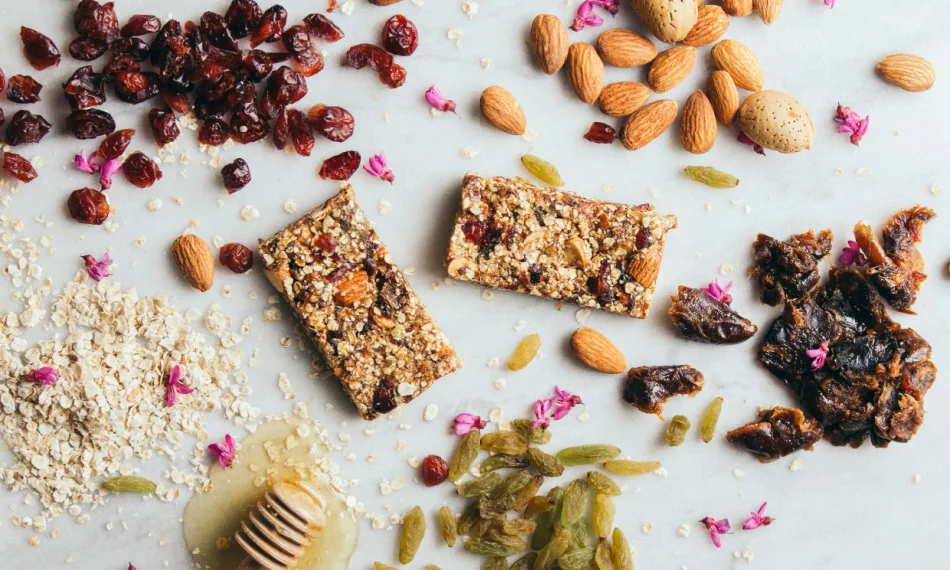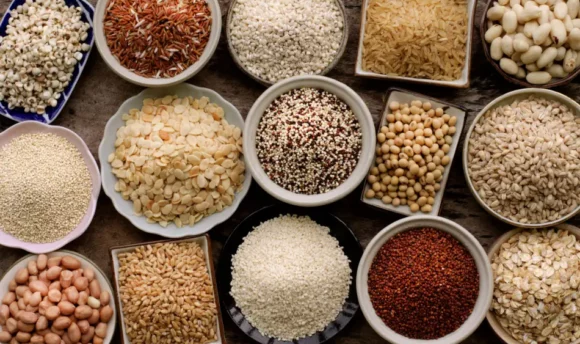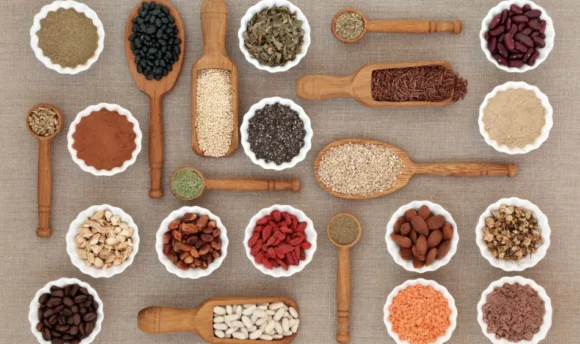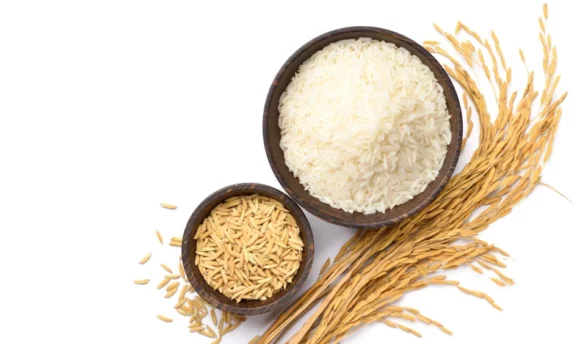Boost Your Day with These 25 High Protein Snack Ideas
Elevate your snacking game with protein-packed bites

Protein plays a vital role in almost all our bodily functions. The amount of protein needed by our bodies can vary from person to person, which is why identifying your unique protein needs is the first step toward achieving your target intake.
Sometimes, meeting your protein goals can be stressful and daunting. High-protein snacks are a great way to solve this issue while satisfying your cravings and boosting your energy.
You don’t need to settle for the limited selection of protein bars and shakes because, in this article, we’ll reveal 25 protein-packed snacks that can be homemade or store-bought and are suitable for various diets.
The Role of Protein in Snacking
Choosing high-protein snacks is snacking smart. Protein takes longer to digest, so consuming protein-rich foods can help you control your appetite and stay full, which can be great if you are trying to lose weight [1].
Whether you are hitting the gym regularly or simply staying active, consuming the right amount of protein for your unique nutritional needs can give you more energy and help you recover faster [2].
Many people think that animal protein is the only real source of protein, but that is not true. Plant-based protein sources like nuts, seeds, and beans are also excellent snacks, suitable for a vegan or vegetarian diet.
Homemade High-Protein Snacks
Having protein bars regularly can get repetitive and leave you wanting something new. Luckily, you can make some delicious high-protein snacks at home with a few ingredients that you may already have in your fridge. Here are a few of them.
#1 Greek yogurt parfait
A creamy Greek yogurt parfait can be a great high-protein snack. Greek yogurt offers about 19 grams of protein per 200 g serving. Incorporating almonds, pistachios, or walnuts can add a few more grams of protein to your parfait.
Layer your ingredients in a jar or bowl. Start with a dollop of plain Greek yogurt for your base, followed by a sprinkle of strawberries, blueberries, or raspberries for some sweetness, vitamin C, and fiber [3]. Add your nuts and repeat the layers until your jar or bowl is full.
Feel free to experiment with different fruit and nut combinations. You can also use chia seeds for added crunch and fiber. The possibilities are endless with this snack.
#2 Protein smoothies
Protein smoothies are perfect if you’re on the go and you want a quick and satisfying protein boost. This protein smoothie recipe uses spinach for added vitamins without overpowering the flavor.
Pour a cup of almond milk into your blender and add one scoop of whey protein powder which offers 20 grams of protein per scoop, or any plant-based protein powder of your choice. Toss in ½ cup of your favorite fruits and ½ cup of spinach, and blend until smooth and creamy.
Add ice for a colder texture, and adjust the amount of milk based on your desired consistency.
#3 Peanut butter celery sticks
Peanut butter celery sticks are great when you need an easy protein snack. Peanut butter provides 3.6 grams of protein per tablespoon. While this is a decent amount of protein, it is also important to note that peanut butter is high in fat and calories, so you need to consume it in moderation especially if you are watching your calorie intake.
Celery contains fiber which slows down your digestion and helps you feel more satiated. Simply wash and trim your celery sticks to start. Spread a tablespoon or two of peanut butter on each celery stick and sprinkle some raisins on top for a sweet, tart touch.
#4 Boiled eggs
Hard-boiled eggs are a filling snack choice for many. They are a complete protein source that contains all essential amino acids and provides you with 6.3 grams of protein per egg. Hard-boiled eggs are also low in calories and readily available, making them a convenient snack you can grab anytime.
Adding a teaspoon of vinegar to the water makes peeling your hard-boiled egg easier. You can enjoy your hard-boiled egg plain, sprinkled with salt and pepper, or incorporate it into a salad with veggies for a satisfying snack.
#5 Cottage cheese bowl
There are so many delicious ways to eat cottage cheese. Making a cottage cheese bowl is just one of them. A 100 g serving of cottage cheese offers 11.6 grams of protein making it a versatile snack that is also loaded with calcium and probiotics.
Scoop your desired amount of cottage cheese into a bowl and get creative with your toppings. Top with some mangoes, pineapple, berries, or whatever fresh fruits you like. You can also sprinkle some cinnamon or drizzle some honey for a touch of sweetness.
#6 Tuna salad on whole grain crackers
This tuna snack combines the powers of protein and fiber to keep you satiated throughout the day. Tuna offers 25.5 grams of protein per 100 g serving. It is also rich in omega-3 fatty acids that help lower the risk of cardiovascular disease and improve cognitive function [4].
Drain and flake your canned tuna. Mix in some Greek yogurt for creaminess (start with one tablespoon and adjust). Season your tuna salad with salt, pepper, lemon, and your desired spices. Spread on whole grain crackers or multigrain bread, and enjoy.
#7 Homemade protein bars
These are perfect as a post-workout snack or an afternoon pick-me-up. Homemade protein bars give you a solid protein dose without the hidden sugars and unhealthy fats that may come with store-bought ones.
Combine 1 cup of rolled oats with 100 grams of your favorite protein powder which can give about 79 grams of protein. Mix in ½ cup of chopped nuts which adds another 11 grams of protein. Gradually add in ¼ cup of almond milk and ¼ cup of honey to bind the mixture. Feel free to add any dried fruits or seeds you like.
Firmly press your mixture into a parchment-lined baking tray and refrigerate for at least 2 hours. Finally, slice into 10 bars and enjoy 9 grams of protein per bar.
Store-Bought High-Protein Snacks
The most important thing with store-bought snacks is choosing the right ones. There are many varieties available for each product, some of which may not be healthiest. Here are some tasty and convenient high-protein snacks you can buy at the store.
#8 Jerky
Jerky is great because it provides you with a concentrated protein dose of up to 33 grams of protein per 100 g serving. Depending on the meat source, jerky can also give you other essential nutrients like iron and zinc. It is filling and can support muscle recovery after your workouts [5].
How to choose: Choosing the healthiest jerky needs some attention. For the highest protein content and healthy omega-3 fats, look for grass-fed turkey, salmon, or beef jerky. Make sure you choose varieties with less sodium and preservatives.
#9 Protein bars
Protein bars are the probably first snack that comes to mind when you need a protein boost. While they can be satisfying, not all protein bars are created equally.
How to choose: Aim for protein bars with less than 10 grams of added sugar per serving because added sugars can contribute calories without adding essential nutrients [6]. Protein bars that use minimal additives and natural whole ingredients like nuts and whole grains are preferred.
#10 Greek yogurt
Greek yogurt is very versatile and can be used in many homemade high-protein snack recipes. It is packed with up to 9.9 grams of protein per 100 g serving. Greek yogurt also contains probiotics and is low in calories, making it a good option if you want to manage your weight while still hitting your protein goals.
How to choose: Opt for plain varieties instead of artificially flavored options to avoid the additives and added sugars. Aim for unsweetened or low-sugar types, and choose the fat content that suits your dietary preferences and calorie needs.
#11 String cheese
This may come as a surprise but string cheese has earned its spot as a high-protein snack that can give you up to 6 grams of protein per piece. It is also high in calcium which maintains bone health and regulates various immune functions [7].
How to choose: Choose string cheese made of part-skim mozzarella so you can reap all the health benefits with less fat than other options. Check the sodium content of your sting cheese, and aim for less than 120 mg of sodium per 100 g serving especially if you are trying to manage your blood pressure.
#12 Roasted chickpeas
Roasted chickpeas are a tasty protein-rich snack that provides 21 grams of protein per serving. Due to their high protein and fiber content, roasted chickpeas can help curb your hunger and keep you full.
How to choose: When it comes to choosing your roasted chickpeas, look for brands with low sodium content. It is also important to note that chickpeas can be quite calorie-dense, so remember to stick to the recommended serving sizes to manage your calorie intake.
#13 Protein shakes
Protein shakes are convenient if you’re trying to build muscle mass and hit your protein intake goals. They can offer up to 30 grams of protein per serving which can prevent snacking and overeating.
How to choose: Protein sources like whey protein, casein protein, and soy protein are recommended [8]. Choose shakes that use recognizable natural ingredients and have low sugar content. Remember to avoid soy protein if you have any soy allergies and thoroughly check the labels of all protein shakes as they may contain a variety of potential allergens.
#14 Edamame
Edamame is a tasty legume rich in protein, fiber, and heart-healthy fats. It is also high in calcium, folate, magnesium, phosphorus, and vitamin K. Pre-shelled edamame comes in packs which makes it a super convenient snack. Edamame can give you up to 11.9 grams of protein per 100 g serving.
How to choose: Choose a low-sodium brand with less than 120 mg of sodium per 100 g serving as an increase in sodium intake can raise your blood pressure and increase the risk of cardiovascular diseases [9]. It is also best to stick to plain or lightly seasoned options instead of spiced options that may come with sauces and extra sodium.
Vegetarian and Vegan High-Protein Snacks
If you’re worried about getting enough protein as a vegan or vegetarian, you are not alone. That is a common concern when it comes to plant-based diets. Here are some protein-rich snacks that will fuel your body and help you feel more satiated.
#15 Hummus and veggies
This snack is simple to prepare, portable, and ideal for lunchboxes. Hummus is an excellent source of protein, fiber, and healthy fats that will keep you feeling full. It is also relatively low in calories. Eating it with veggies gives you those good vitamins and minerals your body needs.
Making hummus at home is very simple, but you can also buy hummus that uses few ingredients and minimal added sugars and preservatives. Hummus can provide about 7.7 grams of protein per 100 g serving. Slice up your vegetables and use hummus as a tasty dip.
#16 Vegan protein bars
Protein bars are a convenient way to get enough protein as a vegan. Especially if you are struggling to meet your protein goals. Vegan protein bars can supply about 11 grams of protein per bar or more depending on the brand you choose.
How to choose: When choosing your bars, pay attention to the protein source to thoroughly check that it is vegan, and choose bars that contain fiber for added satiety. Keep an eye out for the calorie content and experiment with different vegan bars to see which ones taste the best to you.
#17 Nut butter with fruit
Nut butter like almond butter can give you about 6 grams of protein per two tablespoon serving while peanut butter can give you 7 grams of protein per two tablespoon serving. Eating fruits with nut butter adds fiber, vitamins, and minerals to your snack. This promotes digestion and keeps you feeling satisfied. Choose natural nut butter with minimal preservatives and experiment with different fruit and nut butter combinations.
#18 Chia seed pudding
Chia seed pudding isn’t just a trend. It’s a nutritional powerhouse disguised as a delicious, filling snack. Beyond the fact that they offer 4.6 grams of protein per ounce, chia seeds are also loaded with healthy omega-3 fatty acids and a wide variety of vitamins and minerals.
Make your pudding by combining two tablespoons of chia seeds with ½ cup of liquid in your desired container. You can use water, milk, or even fruit juice as liquid. Add your sweeteners if desired. Let your mixture sit for at least 2 hours or overnight for a thicker pudding. Once done, spice up your pudding with fresh fruits, nuts, or seeds as toppings.
#19 Lentil or quinoa salad
Lentil or quinoa salad is a great protein snack for plant-based diets. Lentils give 9 grams of protein per serving, and quinoa offers 4.4 grams of protein per serving.
What’s better is that adding them to your salads boosts your fiber intake which can help with digestion. Lentils and quinoa also add complex carbs to your snack that supply your body with energy.
Boil or simmer your lentils until tender. Cook your quinoa according to package instructions. Rinse and chop your favorite vegetables, and combine them with the quinoa or lentils. Add some fresh cilantro, parsley, paprika, cumin, or a light lemon juice dressing for extra flavor.
Gluten-Free Protein Snacks
If you’re on a gluten-free diet and you want to incorporate more protein into your daily routine, we’ve got you covered. Here are some high-protein snacks that can help you hit your protein goals.
Remember that just because products are labelled gluten-free doesn’t necessarily mean they are healthier for you, so always take into consideration the sugar, fat and calorie content of your snacks.
#20 Almonds or Mixed Nuts
Nuts are a quick and easy gluten-free snack that needs no preparation. Almonds offer about 6 grams of protein per ounce, and mixed nuts can give you about 5 grams of protein per ounce, making them both great snack options that also provide you with a range of nutrients.
Choose raw or dry-roasted options that have minimal added salt and sugars. Remember that nuts can be quite calorie-dense, so sticking to 1–2 ounces per serving is the way to go if you want to manage your calorie intake.
#21 Rice cakes with almond butter
Rice cakes and almond butter are a powerful gluten-free combo. Two tablespoons of almond butter can give you around 7 grams of protein, while two rice cakes can add another 1–2 grams. Both ingredients contain fiber that keeps you satiated.
Start with your brown rice cakes and generously spread your almond butter on top. Start with 1–2 tablespoons and adjust your preference. Top your rice cake with fresh fruit, chopped nuts, seeds, cinnamon, or a drizzle of honey.
#22 Cheese cubes
Cheese is a good gluten-free protein and calcium source. Having a variety of options like cheddar, mozzarella, or Swiss cheese helps you consume a broader range of nutrients. Protein content can vary between different cheese types. Having 7 pieces of cheddar cheese cubes can give you about 7 grams of protein.
How to choose: Natural cheeses are healthier than processed ones with added flavorings and ingredients. Depending on their type, cheese cubes may be high in fat and sodium content, so remember to be mindful of your portion sizes when consuming them.
#23 Gluten-free protein bars
Navigating the endless amount of protein bar options needs some attention. With gluten-free bars, look for a short ingredient list with minimal added sugars, additives, and preservatives. Depending on the brand, one gluten-free protein bar can provide up to 30 grams of protein.
How to choose: High-quality protein sources like whey, casein, and soy protein are recommended as they contain all nine essential amino acids [10]. Remember to always double-check to ensure that the bar is gluten-free and does not contain any other allergens you may have.
#24 Yogurt with gluten-free granola
This satisfying snack can offer up to 26 grams of protein with added probiotics, and fiber. Simply combine half a cup of gluten-free granola (7 grams of protein), with a 200 g serving of Greek yogurt (19.9 grams of protein).
Make sure you choose gluten-free granola that contains whole grains, nuts, and seeds, with minimal added sugars, and unhealthy fats. Greek yogurt is the preferred yogurt for this snack as it has more protein than regular yogurt.
#25 Roasted pumpkin seeds
If you love a crunchy snack, this one is for you. Munching on an ounce of roasted pumpkin seeds can give you about 5 grams of protein. They are also surprisingly rich in micronutrients like magnesium, essential for muscle function and energy production [11].
You can buy raw pumpkin seeds and roast them in olive oil at home to control the salt and oil content. If you’re buying them from the store, avoid those coated in sugary glazes and unhealthy oils. Opt for seeds roasted in healthy fats like olive oil.
Snacking Smart for Fitness Goals
Snacking smart and strategically can be a useful tool for your fitness journey. Whether you’re looking to build muscle, lose weight, or improve endurance, coordinating the timing and distribution of your protein snacks with your fitness goals may improve your results [12].
If you’re looking to build muscle, focus on snacks with 20–40 grams of protein after you train to stimulate muscle protein synthesis and create optimal conditions for post-workout recovery [13]. It is also recommended to evenly distribute your protein snacks every 3–4 hours across the day [14].
For pre-workout energy, focus on snacks with up to 25 grams of protein before your workouts to increase your energy expenditure and help you burn more calories during exercise [15].
If you’re looking to lose weight, choosing high-protein snacks that contain fiber provides added benefits for elevating satiety hormones and helping with weight loss and weight management [16].
A Word From Our RD
FAQ
Yes, high-protein snacks can help with weight loss. Protein takes longer to digest than carbohydrates, which keeps you feeling fuller for longer and prevents overeating.
High-protein snacks can give you that boost of energy you need while helping you feel satisfied. They are also powerful allies if you’re trying to build muscle, lose weight, or improve endurance.
Absolutely. High-protein snacks may help regulate your blood sugar and provide sustained energy that prevents those sudden hunger pangs that cause you to snack [18].
Conclusion
Incorporating protein-packed snacks into your diet can unlock many benefits for you. These snacks can go hand in hand with your weight management efforts, they can help boost your energy, and immune system and support your overall health.
The best part about it is that you get to experiment with limitless possibilities. Use the snacks in this article as a framework, and feel free to mix and match until you find your new favorite high-protein snack.
Sources
- Morell P., Fiszman S. Revisiting the role of protein-induced satiation and satiety. 6/5/2016. https://www.sciencedirect.com/science/article/abs/pii/S0268005X1630340X
- Pearson AG, Hind K, Macnaughton LS. The impact of dietary protein supplementation on recovery from resistance exercise-induced muscle damage: A systematic review with meta-analysis. Eur J Clin Nutr. 2023 Aug. https://www.ncbi.nlm.nih.gov/pmc/articles/PMC10393778/
- Skrovankova S, Sumczynski D, Mlcek J, Jurikova T, Sochor J. Bioactive Compounds and Antioxidant Activity in Different Types of Berries. Int J Mol Sci. 2015 Oct 16. https://www.ncbi.nlm.nih.gov/pmc/articles/PMC4632771/
- Jain AP, Aggarwal KK, Zhang PY. Omega-3 fatty acids and cardiovascular disease. Eur Rev Med Pharmacol Sci. 2015. https://pubmed.ncbi.nlm.nih.gov/25720716/
- di Corcia M, Tartaglia N, Polito R, Ambrosi A, Messina G, Francavilla VC, Cincione RI, Della Malva A, Ciliberti MG, Sevi A, Messina G, Albenzio M. Functional Properties of Meat in Athletes’ Performance and Recovery. Int J Environ Res Public Health. 2022 Apr 23. https://www.ncbi.nlm.nih.gov/pmc/articles/PMC9102337/
- U.S. Department of Agriculture and U.S. Department of Health and Human Services. Dietary Guidelines for Americans, 2020-2025. 9th Edition. https://www.dietaryguidelines.gov/sites/default/files/2020-12/Dietary_Guidelines_for_Americans_2020-2025.pdf Accessed 01/25/2024.
- The Harvard T.H. Chan School of Public Health. Calcium. https://www.hsph.harvard.edu/nutritionsource/calcium/ Accessed 01/25/2024
- Hoffman JR, Falvo MJ. Protein – Which is Best? J Sports Sci Med. 2004 Sep 1. https://www.ncbi.nlm.nih.gov/pmc/articles/PMC3905294/
- Aburto NJ, Ziolkovska A, Hooper L, Elliott P, Cappuccio FP, Meerpohl JJ. BMJ. 2013. https://www.bmj.com/content/346/bmj.f1326
- The Harvard T.H. Chan School of Public Health. Workout supplements. https://www.hsph.harvard.edu/nutritionsource/workout-supplements/ Accessed 01/25/2024
- The Harvard T.H. Chan School of Public Health. Magnesium. https://www.hsph.harvard.edu/nutritionsource/magnesium/ Accessed 01/25/2024
- Areta JL, Burke LM, Ross ML, Camera DM, West DW, Broad EM, Jeacocke NA, Moore DR, Stellingwerff T, Phillips SM, Hawley JA, Coffey VG. Timing and distribution of protein ingestion during prolonged recovery from resistance exercise alters myofibrillar protein synthesis. J Physiol. 2013 May 1. https://pubmed.ncbi.nlm.nih.gov/23459753/
- Rowlands DS, Nelson AR, Phillips SM, Faulkner JA, Clarke J, Burd NA, Moore D, Stellingwerff T. Protein-leucine fed dose effects on muscle protein synthesis after endurance exercise. Med Sci Sports Exerc. 2015 Mar. https://pubmed.ncbi.nlm.nih.gov/25026454/
- Jäger, R., Kerksick, C.M., Campbell, B.I. et al. International Society of Sports Nutrition Position Stand: protein and exercise. J Int Soc Sports Nutr 14, 20. 2017. https://doi.org/10.1186/s12970-017-0177-8
- Gieske, B.T., Stecker, R.A., Smith, C.R. et al. Metabolic impact of protein feeding prior to moderate-intensity treadmill exercise in a fasted state: a pilot study. J Int Soc Sports Nutr 15, 56. 2018. https://doi.org/10.1186/s12970-018-0263-6
- Heather J Leidy, Peter M Clifton, Arne Astrup, Thomas P Wycherley, Margriet S Westerterp-Plantenga, Natalie D Luscombe-Marsh, Stephen C Woods, Richard D Mattes. The role of protein in weight loss and maintenance. The American Journal of Clinical Nutrition. Volume 101, Issue 6. 2015. https://doi.org/10.3945/ajcn.114.084038
- McKiernan F, Houchins JA, Mattes RD. Relationships between human thirst, hunger, drinking, and feeding. Physiol Behav. 2008 Aug 6. https://www.ncbi.nlm.nih.gov/pmc/articles/PMC2467458/
- Luhovyy BL, Kathirvel P. Food proteins in the regulation of blood glucose control. Adv Food Nutr Res. 2022. https://pubmed.ncbi.nlm.nih.gov/36064293/

















































 Select your language:
Select your language: 








